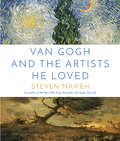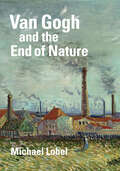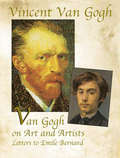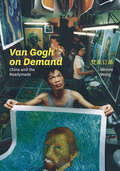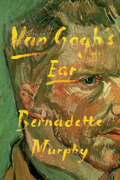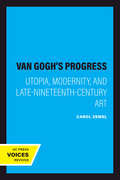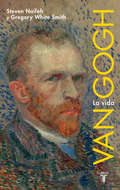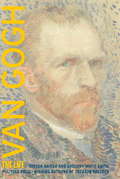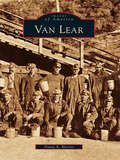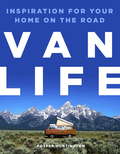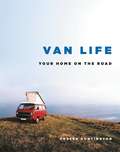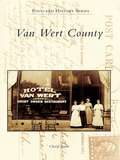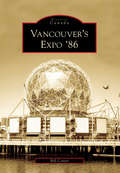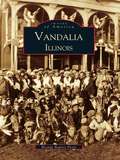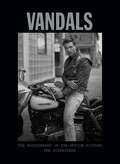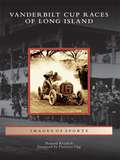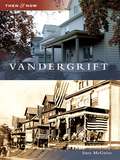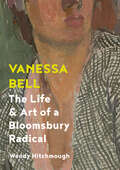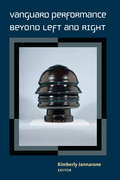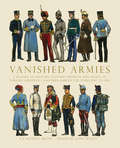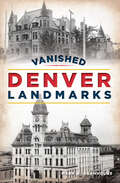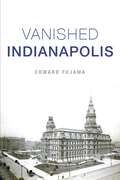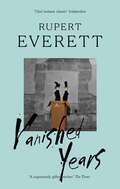- Table View
- List View
Van Gogh and the Artists He Loved
by Steven NaifehThe compelling story of how Vincent van Gogh developed his audacious, iconic style by immersing himself in the work of others, featuring hundreds of paintings by Van Gogh as well as the artists who inspired him—from the New York Times bestselling co-author of Van Gogh: The Life&“Important . . . inspires us to look at Van Gogh and his art afresh.&”—Dr. Chris Stolwijk, general director, RKD–Netherlands Institute for Art History Vincent van Gogh&’s paintings look utterly unique—his vivid palette and boldly interpretive portraits are unmistakably his. Yet however revolutionary his style may have been, it was actually built on a strong foundation of paintings by other artists, both his contemporaries and those who came before him. Now, drawing on Van Gogh&’s own thoughtful and often profound comments about the painters he venerated, Steven Naifeh gives a gripping account of the artist&’s deep engagement with their work. We see Van Gogh&’s gradual discovery of the subjects he would make famous, from wheat fields to sunflowers. We watch him experimenting with the loose brushwork and bright colors used by Édouard Manet, studying the Pointillist dots used by Georges Seurat, and emulating the powerful depictions of the peasant farmers painted by Jean-François Millet, all vividly illustrated in nearly three hundred full-color images of works by Van Gogh and a variety of other major artists, including Claude Monet, Paul Gauguin, and Henri de Toulouse-Lautrec, positioned side by side. Thanks to the vast correspondence from Van Gogh to his beloved brother, Theo, Naifeh, a Pulitzer Prize winner, is able to reconstruct Van Gogh&’s artistic world from within. Observed in eloquent prose that is as compelling as it is authoritative, Van Gogh and the Artists He Loved enables us to share the artist&’s journey as he created his own daring, influential, and widely beloved body of work.
Van Gogh and the End of Nature
by Michael LobelA groundbreaking reassessment that foregrounds Van Gogh’s profound engagement with the industrial age while making his work newly relevant for our world today Vincent van Gogh (1853–1890) is most often portrayed as the consummate painter of nature whose work gained its strength from his direct encounters with the unspoiled landscape. Michael Lobel upends this commonplace view by showing how Van Gogh’s pictures are inseparable from the modern industrial era in which the artist lived—from its factories and polluted skies to its coal mines and gasworks—and how his art drew upon waste and pollution for its subjects and even for the very materials out of which it was made. Lobel underscores how Van Gogh’s engagement with the environmental realities of his time provides repeated forewarnings of the threats of climate change and ecological destruction we face today. Van Gogh and the End of Nature offers a radical revisioning of nearly the full span of the artist’s career, considering Van Gogh’s artistic process, his choice of materials, and some of his most beloved and iconic pictures. Merging a timely sense of environmental urgency with bold new readings of the work of one of the world’s most acclaimed artists, this book weaves together detailed historical research and perceptive analysis into an illuminating portrait of an artist and his changing world.
Van Gogh and the Post-Impressionists for Kids: Their Lives and Ideas, 21 Activities
by Carol SabbethVincent van Gogh's admiration for and departure from Impressionism and his relationships with the other enthusiastic, like-minded artists who ultimately formed the Post-Impressionist movement are explained and explored in this collection of art activities for kids. Debunking the persistent stereotype of the mad pauper who cut off his ear, van Gogh is revealed as the serious boy who loved nature and reading and spoke four languages; the young man who took great satisfaction in the study of art, his successful career as a gallery salesman, and the "brotherhood of artists" he helped to create; and the increasingly troubled and ill man who cared deeply for family and friends and tried in vain to recover. Through a series of fun and creative projects, such as a Starry Night Peep Box, a Pointillist Sailboat, and a Japanese Fold-out Album, kids will be exposed to such art as van Gogh's vibrant landscapes, Paul Signac's Mediterranean Sea images in dazzling dots, and Paul Gauguin's tropical landscapes in unnatural colors. Aspiring young artists and history buffs will learn whether or not these famous painters always got along, how they helped each other in the process, and what made Post-Impressionist art unlike anything ever painted.
Van Gogh on Art and Artists: Letters to Emile Bernard
by Vincent Van GoghThese letters, written from 1887 to 1889, are among the most important and relevant sources of insight into van Gogh's life and art. 23 missives, accompanied by reproductions of a number of his major paintings and facsimiles from his letters, radiate their author's impulsiveness, intensity, and mysticism. Chronology. Select Bibliography. Index. 32 full-page black-and-white illustrations.
Van Gogh on Demand: China and the Readymade
by Winnie Won Yin WongIn a manufacturing metropolis in south China lies Dafen, an urban village that famously houses thousands of workers who paint van Goghs, Da Vincis, Warhols, and other Western masterpieces for the world market, producing an astonishing five million paintings a year. To write about work and life in Dafen, Winnie Wong infiltrated this world, first investigating the work of conceptual artists who made projects there; then working as a dealer; apprenticing as a painter; surveying wholesalers and retailers in Europe, East Asia and North America; establishing relationships with local leaders; and organizing a conceptual art exhibition for the Shanghai World Expo. The result is Van Gogh on Demand, a fascinating book about a little-known aspect of the global art world--one that sheds surprising light on the workings of art, artists, and individual genius. Confronting big questions about the definition of art, the ownership of an image, and the meaning of originality and imitation, Wong describes an art world in which idealistic migrant workers, lofty propaganda makers, savvy dealers, and international artists make up a global supply chain of art and creativity. She examines how Berlin-based conceptual artist Christian Jankowski, who collaborated with Dafen's painters to reimagine the Dafen Art Museum, unwittingly appropriated the work of a Hong Kong-based photographer Michael Wolf. She recounts how Liu Ding, a Beijing-based conceptual artist, asked Dafen "assembly-line" painters to perform at the Guangzhou Triennial, neatly styling himself into a Dafen boss. Taking the Shenzhen-based photojournalist Yu Haibo's award-winning photograph from the Amsterdam's World Press Photo organization, she finds and meets the Dafen painter pictured in it and traces his paintings back to an unlikely place in Amsterdam. Through such cases, Wong shows how Dafen's painters force us to reexamine our preconceptions about creativity, and the role of Chinese workers in redefining global art. Providing a valuable account of art practices in an ascendant China, Van Gogh on Demand is a rich and detailed look at the implications of a world that can offer countless copies of everything that has ever been called "art. "
Van Gogh's Ear
by Bernadette MurphyThe best-known and most sensational event in Vincent van Gogh's life is also the least understood. For more than a century, biographers and historians seeking definitive facts about what happened on a December night in Arles have unearthed more questions than answers. Why would an artist at the height of his powers commit such a brutal act? Who was the mysterious "Rachel" to whom he presented his macabre gift? Did he use a razor or a knife? Was it just a segment--or did Van Gogh really lop off his entire ear? In Van Gogh's Ear, Bernadette Murphy reveals, for the first time, the true story of this long-misunderstood incident, sweeping away decades of myth and giving us a glimpse of a troubled but brilliant artist at his breaking point. Murphy's detective work takes her from Europe to the United States and back, from the holdings of major museums to the moldering contents of forgotten archives. She braids together her own thrilling journey of discovery with a narrative of Van Gogh's life in Arles, the sleepy Provençal town where he created his finest work, and vividly reconstructs the world in which he moved--the madams and prostitutes, café patrons and police inspectors, shepherds and bohemian artists. We encounter Van Gogh's brother and benefactor Theo, his guest and fellow painter Paul Gauguin, and many local subjects of Van Gogh's paintings, some of whom Murphy identifies for the first time. Strikingly, Murphy uncovers previously unknown information about "Rachel"--and uses it to propose a bold new hypothesis about what was occurring in Van Gogh's heart and mind as he made a mysterious delivery to her doorstep. As it reopens one of art history's most famous cold cases, Van Gogh's Ear becomes a fascinating work of detection. It is also a study of a painter creating his most iconic and revolutionary work, pushing himself ever closer to greatness even as he edged toward madness--and one fateful sweep of the blade that would resonate through the ages.
Van Gogh's Progress: Utopia, Modernity, and Late-Nineteenth-Century Art (California Studies in the History of Art #36)
by Carol ZemelThis title is part of UC Press's Voices Revived program, which commemorates University of California Press’s mission to seek out and cultivate the brightest minds and give them voice, reach, and impact. Drawing on a backlist dating to 1893, Voices Revived makes high-quality, peer-reviewed scholarship accessible once again using print-on-demand technology. This title was originally published in 1997.This title is part of UC Press's Voices Revived program, which commemorates University of California Press’s mission to seek out and cultivate the brightest minds and give them voice, reach, and impact. Drawing on a backlist dating to 1893, Voices Revived</DIV
Van Gogh: A Beginner's Guide (A\beginner's Guide Key Figures Ser.)
by Andrew ForrestVincent Van Gogh had a profound gift of communication, and he remains an icon of modern art to this day. This book will explore Van Gogh's life, influences, English connections, painting techniques, perceptions of Van Gogh and the continuing Van Gogh phenomenon.
Van Gogh: La vida
by Steven Naifeh Gregory White SmithPor fin, el retrato completo del incomparable maestro. Vida, muerte y genialidad de la mano de dos ganadores del premio Pulitzer Van Gogh trabajó como marchante de arte con escaso éxito, intentó convertirse en predicador, hizo incursiones como ilustrador de revistas y, por último, tuvo una carrera de pintor tan brillante como corta. Cuando murió en Francia a los 37 años sus cuadros se amontonaban, sin que casi nadie los mirase, en los armarios, desvanes y habitaciones de sus parientes, amigos y acreedores. Sin embargo, en su breve y tempestuosa vida, Vincent van Gogh había cambiado el curso del arte occidental para siempre. Trabajando con la plena colaboración del Museo Van Gogh de Ámsterdam, Steven Naifeh y Gregory White Smith, ganadores del Premio Pulitzer por su biografía de Jackson Pollock, han tenido acceso a materiales inéditos, incluyendo correspondencia familiar hasta ahora desconocida, para recrear, con increíble viveza y una sorprendente precisión psicológica, la extraordinaria vida del pintor. Los autores arrojan nueva luz sobre muchos de los aspectos inexplorados de la existencia de Van Gogh: su permanente lucha para encontrar su lugar en el mundo, su intensa relación con su hermano Theo, su errática y tumultuosa vida sentimental y sus ataques de depresión y problemas mentales. Ofrecen además un convincente e inesperado relato sobre las circunstancias de su muerte que da un vuelco a las teorías manejadas hasta ahora. Esta monumental biografía es, sin duda, el retrato definitivo de uno de los grandes genios de la historia del arte. La crítica ha dicho...«Para esta generación, el retrato definitivo del pintor. El logro más importante de Naifeh y Smith es haber logrado un ajuste de cuentas con la -locura- ocasional de Van Gogh que no pierde de vista la lucidez y la inteligencia -la profunda cordura- de su arte.»Time «Una biografía que se lee como una novela, llena de suspense y detalles íntimos.»The Washington Post «En su magistral nueva biografía Steven Naifeh y Gregory White Smith ofrecen una visita guiada por el mundo personal y la obra de este pintor holandés, iluminando la evolución de su arte a la vez que elaboran una teoría sobre su muerte destinada a crear controversia.»The New York Times «Cautivador... Los autores reconstruyen vívidamente las historias entrelazadas de su vida y su arte, retratándolo como una "víctima de su propio corazón fanático". Su excelente libro tiene el potencial no sólo de revitalizar el interés popular por Van Gogh, sino de presentar a uno de los espíritus más valiosos de la historia del arte a toda una nueva generación.»The Wall Street Journal «Una nueva teoría sobre la muerte de Vincent van Gogh puede acabar reescribiendo la historia del arte... Después de leer cientos de documentos, de libros traducidos para ellos por el museo Van Gogh y de recorrer la correspondencia del artista, la obra dibuja a un hombre más complejo de lo mostrado hasta la fecha.»El País
Van Gogh: The Life
by Steven Naifeh Gregory White SmithSteven Naifeh and Gregory White Smith, who galvanized readers with their Pulitzer Prize–winning biography of Jackson Pollock, have written another tour de force—an exquisitely detailed, compellingly readable portrait of Vincent van Gogh. Working with the full cooperation of the Van Gogh Museum in Amsterdam, Naifeh and Smith have accessed a wealth of previously untapped materials to bring a crucial understanding to the larger-than-life mythology of this great artist: his early struggles to find his place in the world; his intense relationship with his brother Theo; and his move to Provence, where he painted some of the best-loved works in Western art. The authors also shed new light on many unexplored aspects of Van Gogh’s inner world: his erratic and tumultuous romantic life; his bouts of depression and mental illness; and the cloudy circumstances surrounding his death at the age of thirty-seven. Though countless books have been written about Van Gogh, no serious, ambitious examination of his life has been attempted in more than seventy years. Naifeh and Smith have re-created Van Gogh’s life with an astounding vividness and psychological acuity that bring a completely new and sympathetic understanding to this unique artistic genius. NEW YORK TIMESBESTSELLER Praise forVan Gogh: The Life “Magisterial. ”—Michiko Kakutani, The New York Times “This generation’s definitive portrait of the great Dutch post-Impressionist. ”—Time “A tour de force . . . an enormous achievement . . . Reading his life story is like riding an endless roller coaster of delusional highs and lows. . . . [A] sweepingly authoritative, astonishingly textured book. ”—Los Angeles Times “Marvelous . . . [Van Gogh] reads like a novel, full of suspense and intimate detail. . . . In beautiful prose, Naifeh and Smith argue convincingly for a subtler, more realistic evaluation of Van Gogh, and we all win. ”—The Washington Post “Brilliant . . . At once a model of scholarship and an emotive, pacy chunk of hagiography. ”—The Daily Telegraph(London) ANEW YORK TIMESNOTABLE BOOK NAMED ONE OF THE BEST BOOKS OF THE YEAR BYTHE WASHINGTON POST • THE WALL STREET JOURNAL • SAN FRANCISCO CHRONICLE• NPR •THE ECONOMIST • NEWSDAY• BOOKREPORTER
Van Lear
by Danny K. BlevinsVan Lear was a sparsely populated farm community at the dawn of the 20th century. Known originally as Miller's Creek, its pastoral nature was soon lost as it transformed into a thriving municipality. John C. C. Mayo, a young schoolmaster, was the force behind this development. With his geologic knowledge and his forward-looking business savvy, he foresaw the economic power of the veins of bituminous coal that lay undisturbed in much of Eastern Kentucky. Mayo and a small nucleus of businessmen acquired vast tracts of land and mineral rights. In the case of Miller's Creek, these holdings were sold to a corporate behemoth, the Consolidation Coal Company (Consol). Mayo became one of Kentucky's wealthiest citizens, and Miller's Creek became Van Lear.
Van Life: Your Home On The Road
by Foster Huntington'Beautifully illustrated with photos of retro vans and their owners, this collection is from the creator of the hashtag #vanlife, and is as much about exploring nature as it is about what 'rig' you drive' The Pool More and more people are taking a break from conventional life for the freedom and adventure of being on the road and living in a converted vintage truck, camper, or van.One of these vandwellers, Foster Huntington, created the #vanlife hashtag as he chronicled his adventures living in a van while driving across country. He tapped into a community of like-minded individuals looking to explore nature at their own pace. VAN LIFE showcases the best crowd-sourced photographs of stunning beaches, misty forests, and rocky mountains from Foster's tumblr account, many of which have never been posted.
Van Life: Your Home on the Road
by Foster HuntingtonShowcasing hundreds of funky vehicles, awe-inspiring landscapes, and cleverly designed interiors in tiny spaces from around the world, Van Life is perfect for who anyone daydreams about living on the open road.More and more people-from millennials to baby boomers-are taking a break from conventional life for the freedom, tranquility, and adventure of being on the road and living in a converted vintage truck, camper, or van.One of these vandwellers, Foster Huntington, created the #vanlife hashtag as he chronicled his adventures living in a van while driving it across the country. He tapped into a community of like-minded individuals looking to explore nature at their own pace and live a debt-free lifestyle.Van Life showcases the best crowd-sourced photographs from Foster's tumblr account, van-life.net, many of which have never been posted. Organized into sections like Volkswagen vans, American vans, converted vans, school buses, and more, the hundreds of photos include shots of the unique vehicles, the beautiful locations they've been parked including stunning beaches, dramatic mountains and picturesque forests, fully designed interiors with kitchens and sleeping quarters, and more.Also included are interviews with solo travelers, couples, and families who are living this new American dream.
Van Wert County (Postcard History Series)
by Cheryl BauerFounded by an adventurer and named for a Revolutionary War hero, Van Wert County has seen plenty of excitement since 1821. The transformation from Native American camps and swampland to thriving farms and businesses happened rapidly. Vintage postcards printed between the 1870s and 1950s capture moments of work and leisure, civic pride, and private celebration. Take a look at life in the ever-evolving county seat, and then stroll down the main streets of the communities that have contributed so much to history. Take time to smell the peonies and to reminisce about the Van Wert County Fair that has delighted fairgoers since 1856. In these vintage postcards from Convoy, Delphos, Middlepoint, Scott, Van Wert, Venedocia, Willshire, and Wren, readers can enjoy a glimpse of the past and perhaps even a look at some old friends.
Vancouver's Expo '86 (Historic Canada)
by Bill CotterTo mark the 100th anniversary of the city's founding and the arrival of the first trans-Canada train, Vancouver's political and business leaders invited the whole world to participate in the festivities.The result was Expo '86, and more than 22 million people came for the party. It took eight years of planning and hard work to transform a former railroad yard into a colourful showplace full of pavilions and shows for the six-month event, but those lucky enough to have been there would agree that it was worth it. Expo '86, truly a world's fair,included pavilions from 9 provinces and territories, 54 nations and international groups, and 3 American states. Many of Canada's largest industries joined in, as well, to celebrate the fair's theme, "A Worldin Movement, A World in Touch." Vintage photographs recapture the fun and excitement of the largest event held to that time in British Columbia.
Vandalia, Illinois (Images of America)
by Brenda Baptist ProtzSituated on the Kaskaskia River is the community of Vandalia, Illinois, a town proud of its place in history and excited about its future. Vandalia has proved that as the place where Abraham Lincoln began his political career, and the location of the terminus of the Cumberland Road, it is a town of global historical importance.Vandalia, Illinois contains many previously unpublished photographs, and not only highlights Vandalia's place in Illinois state politics, but also touches on those unique individuals, families, events, and businesses that helped shape it. Vandalia served as Illinois' capital from 1819-1839, when Springfield took over that honor. During the 20 years it served as the capital of Illinois, Vandalia became the starting point for many political and professional careers-most notably a young, beardless Abe Lincoln.
Vandals: The Photography of The Bikeriders
by Insight EditionsEmbark on a remarkable visual journey into the creation of Jeff Nichols&’s The Bikeriders with this unforgettable collection of exclusive photography from the film&’s set.Inspired by Danny Lyon&’s seminal 1968 book, The Bikeriders, this powerful drama from director Jeff Nichols (Midnight Special, Mud) follows the rise and fall of a midwestern motorcycle club. Featuring an all-star cast that includes Jodie Comer, Tom Hardy, Austin Butler, Michael Shannon, and Boyd Holbrook, Nichols&’s film is an evocative snapshot of a renegade era. This book features exclusive photography from the set, plus commentary from the director and his cast and crew. NEVER-BEFORE-SEEN IMAGERY: Go behind the scenes of The Bikeriders with exclusive photography. ACCLAIMED CAST: The book features imagery of the film&’s stellar cast, which includes Jodie Comer (Killing Eve), Austin Butler (Elvis), and Tom Hardy (Venom). INTERVIEWS WITH CREATORS AND CAST: Dive into the creation of the film through exclusive interviews with Jeff Nichols, his crew, and the film&’s cast.
Vanderbilt Cup Races of Long Island (Images of Sports)
by Florence Ogg Howard Kroplick"Chain your dogs and lock up your fowls!" heralded posters announcing the first international road race in the United States and the first of the six William K. Vanderbilt Jr. Cup Races held on Long Island from 1904 to 1910. These races were the most prestigious sporting events of their day, drawing huge crowds from 25,000 to over 250,000 spectators. The Vanderbilt Cup Races had a far-reaching impact on the development of American automobiles and parkways and are a testament to the early racing spirit and drama. The rare images in this book, many published for the first time, have been selected from the archives of major museums, libraries, and private collectors.
Vandergrift
by Sara McguireEstablished in 1895 when other factory towns consisted of shabby mill-owned structures and dirt streets, Vandergrift, Pennsylvania, was uniquely designed by the firm of Olmsted, Olmsted and Eliot to be greener and more architecturally pleasing for residents. The town's early emphasis on green space and resident-owned homes was ahead of its time, and aspects of its history continue to surprise even residents.
Vanessa Bell: The Life and Art of a Bloomsbury Radical
by Wendy HitchmoughOne of Britain&’s most radical and influential artists working in the first decades of the twentieth century, Vanessa Bell was a pioneer for professional women Vanessa Bell was a leading figure within the Bloomsbury Group and known for her unconventional lifestyle, but her work as a painter, designer, and decorator has often been overlooked and relegated within the bombastic, male-dominated field of British modernism. With new research, including previously unpublished letters, Wendy Hitchmough explores the ways in which Bell (1879–1961) forged new pathways as a modernist woman. Writing openly about depression and mental health at a time when the subject was stigmatised, as well as challenging taboos surrounding women&’s bodies, Bell exploited the patriarchal society that oppressed her. She responded to the nudes and pastoral scenes of Cézanne, Gauguin, Picasso, and Matisse with themes of miscarriage and motherhood. She exhibited with her partner, Duncan Grant, and comparisons between their parallel careers highlight the gender disparities that shaped her life and work. Vanessa Bell: The Life and Art of a Bloomsbury Radical celebrates the artist&’s trailblazing approach to art as well as life, her rejection of conventions, and the challenge she posed to the structures of early twentieth-century society.
Vanguard Performance Beyond Left And Right
by Kimberly JannaroneVanguard Performance Beyond Left and Right challenges assumptions regarding "radical" and "experimental" performance that have long dominated thinking about the avant-garde. The book brings to light vanguard performances rarely discussed: those that support totalitarian regimes, promote conservative values, or have been effectively snapped up by right-wing regimes the performances intended to oppose. In so doing, the volume explores a central paradox: how innovative performances that challenge oppressive power structures can also be deployed in deliberate, passionate support of oppressive power. Essays by leading international scholars pose engaging questions about the historical avant-garde, vanguard acts, and the complex role of artistic innovation and live performance in global politics. Focusing on performances that work against progressive and democratic ideas (including scripted drama, staged suicide, choral dance, terrorism, rallies, and espionage), the book demonstrates how many compelling performance ideals--unification, exaltation, immersion--are, in themselves, neither moral nor immoral; they are only emotional and aesthetic urges that can be powerfully channeled into a variety of social and political outlets.
Vanished Armies
by Ae MillerIn the years immediately before the First World War Archibald Haswell Miller, a young artist, traveled Europe to study painting. While he was there he indulged his other great interest - military matters. On his travels he observed first-hand the soldiers of the European Armies in the last days of the colourful and elaborate uniforms that were giving way to grey and khaki across the continent. Realizing that this was a great military heritage that was slipping away, he set out to record these splendid uniforms.In the uncertain days before the assassination of the Archduke Ferdinand in Sarajevo, Haswell Miller sketched and painted hundreds of figures, each wearing a different uniform from the armies of Britain, Germany, France, Austria-Hungary, Belgium, Holland, Italy, Portugal, Russia, Spain and Sweden. Just before the First World War the paintings were exhibited in Leipzig, and it seemed they might be published. But when war broke out they returned home and lay forgotten for nearly one hundred years.Now, published together at last, they represent a unique record of the uniforms of the last great age of military dress. Accompanied by, in Haswell Miller's own words, 'notes and memories of the days before "the lights went out in Europe" in the year 1914', this is a book of great historical importance.
Vanished Denver Landmarks (Lost)
by Mark A. BarnhouseFrom its 1858 birth, the Mile High City has undergone continuous change, with each successive generation putting its stamp on Denver's architectural character. Along the way, landmarks initially considered first class were later deemed disposable by those who had different visions of what Denver should be. Beloved buildings like the Tabor Grand Opera House, the Windsor Hotel and the Republic Building vanished. Historian Mark A. Barnhouse revisits these lost treasures along with the lesser known and rarely explored, including an apartment building dubbed "Denver's Bohemia," the humble abode of one of the early twentieth century's most successful novelists and the opulent mansion of a man who gave Denver three consecutive baseball championships.
Vanished Indianapolis (Lost)
by Edward FujawaUncover lost gems of Circle City history More than two centuries removed from its founding, Indianapolis has seen its share of landmarks and landscapes pass into memory. Some have totally vanished, such as the National Road covered bridge over the White River, the Marion County courthouse , the 1835 Indiana statehouse, and the previous headquarters for the long-standing Flanner House organization. Others still exist, but not in their original location or form, like Pogue's Run, the Central Canal through downtown, and the remnants of structures at Riverside Park. Indianapolis historian Edward Fujawa explores the history of lost sites, how they appear today, and how some are still used or repurposed.
Vanished Years
by Rupert Everett'[An] instant classic' IndependentRupert Everett's first memoir - Red Carpets and Other Banana Skins - was an international bestseller and an instant classic on publication in 2006. Reviewers compared him to Evelyn Waugh, David Niven, Noel Coward and Lord Byron. But Rupert Everett is - of course - one of a kind.Mischievous, touching and nothing less than brilliant, this new memoir is filled with stories, from childhood to the present. Astonishing encounters; tragedy and comedy; vivid portraits of friends and rivals; razor-sharp observations of the celebrity circus from LA to London and beyond... there is something extraordinary on every page. A pilgrimage to Lourdes with his father is both hilarious and moving. A misguided step into reality TV goes horribly wrong. From New York to Moscow to Berlin to Phnom Penh, Vanished Years takes the reader on a wild and wonderful new journey with a charming (and rather disreputable) companion.
